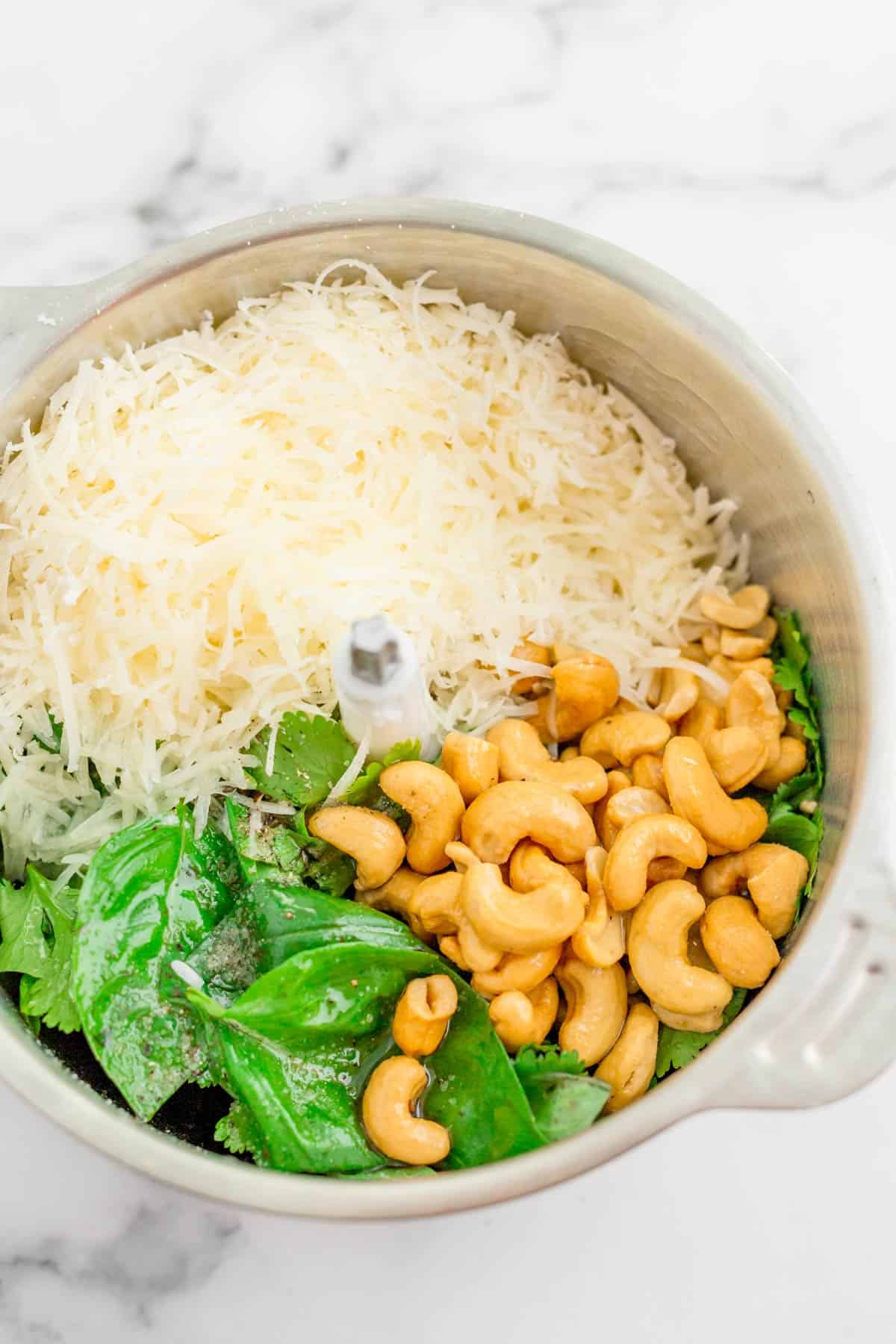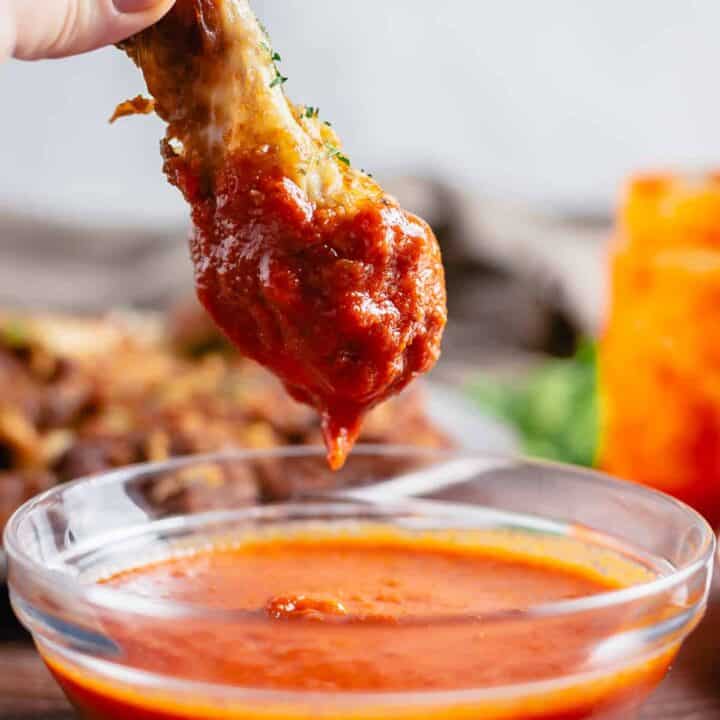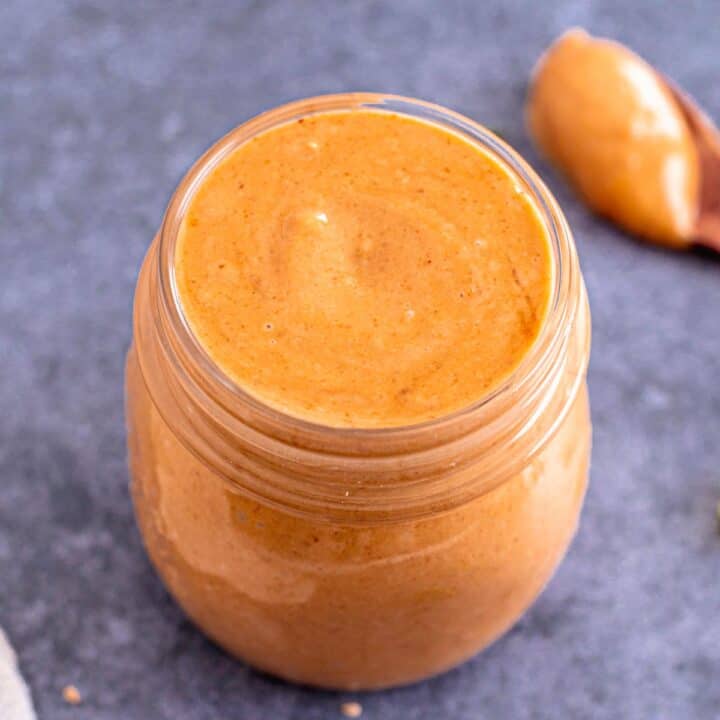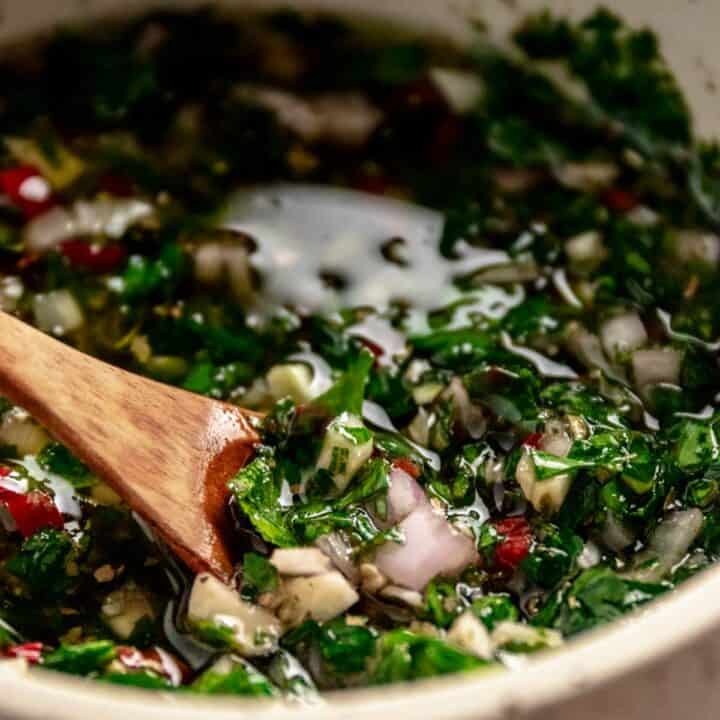This Cashew Pesto is a highly nutritious homemade basil pesto bursting with fresh flavors and vibrant green color that is ideal when paired with pasta, fish, poultry, and other types of meat.
Homemade Cashew pesto is made with simple ingredients and comes together in minutes. The toasted cashews in this pesto have rich flavor and creaminess while the parmesan cheese adds to the decadence.
While this pesto calls for minimal ingredients, it’s definitely one that will impress the family and guests!
My favorite way to use this pesto - Air Fryer Tilapia With Pesto.
Skip your traditional go-to tomato sauce-based pasta and make restaurant-quality pesto pasta instead. kids love green pasta!
Jump To

Ingredients
- Fresh herbs - use lots of basil leaves for the best taste, they’re the star ingredient of this pesto. That said, you could also use rocket/arugula or even baby spinach as a tasty variation. A little cilantro addition would work well here too.
- Cashews - the toasted cashews add another rich depth of flavor to this pesto. You can either purchase toasted nuts (I prefer unsalted cashews) or roast cashews yourself (in a dry pan or oven). Cashews or pine nuts are preferred for their creaminess and flavor but any other nut will be fine too: Walnuts, almonds, macadamia nuts, pecans, pistachios, sunflower seeds, pumpkin seeds, sesame seeds, and peanuts.
- Parmigiano Reggiano - or honestly any other type of hard cheese that is similar. PRO TIP: Grating your cheese from a block instead of using pre-shredded cheese will also yield a better taste and texture in food.
- Vegan pesto - If you’d like to make this pesto vegan-friendly then use vegan parmesan cheese or nutritional yeast flakes instead. You may need to adjust other ingredient amounts to achieve the ultimate best flavor to match your taste buds accordingly.
- Lemon juice - Juice freshly squeezed from a lemon is always my first choice. It also helps to balance the rich flavors in this pesto recipe.
- Olive oil - always use quality olive oil (just a good true and tried brand, doesn't have to be an extra virgin oil) for homemade condiments.
- Garlic - I’ve used fresh garlic cloves for this pesto but pre-minced garlic or even garlic powder will also work. While I love the use of garlic in this pesto, be careful that you don’t overdo it otherwise it can overpower the other flavors in the pesto.
Check the step-by-step photos below the recipe card.
Want to Save This Recipe?
Enter your email and we’ll send the recipe directly to you!
By submitting this form, you consent to receive emails from The Yummy Bowl.
Tips
- When blending the pesto ingredients, feel free to use a little less or more olive oil to achieve the consistency desired.
- The parmesan cheese is already quite high in sodium so you won’t need to add too much salt and pepper. It’s best to taste to test as you blend, adapting as required.
- When serving the cashew pesto with pasta, reserve some pasta cooking water as it makes a fantastic thickener for pesto (if needed).
- When toasting raw cashews for this pesto, make sure that they are completely cool before adding them to the blender with the other ingredients.
- When handling fresh basil, be careful as it is very sensitivity to heat. Basil can turn blackish when exposed to high temperatures. Therefore, if you're garnishing a dish like pasta with fresh chopped basil, it's best to add it onto each plate just before serving rather than mixing it into hot ingredients in a pan or skillet.
- Pesto varieties: cashews give the creamiest and smoothest result but a similar texture can be achieved with almonds, and walnut. Or substitute basil with spinach, cilantro, or kale.
Serving Suggestions
- A kid's favorite. Make a simple basil pesto pasta with spaghetti, fettuccine, or short pasta. Mix in some sun-dried tomatoes, sauteed mushrooms, or zucchini. And if your kid is older, I like to add red pepper flakes when serving.
- Potato Salads
- Most of pasta dishes, pasta salads - just swap the sauces and dressings in those dishes to this Basil Cashew Pesto.
- Sauce for fish and poultry
- As a dipping sauce

Freezing And Storing Instructions
Cashew pesto storing: sealed, in a glass container for up to 2-3 days in the fridge or for 2-3 months in a freezer bag in the freezer. Thaw overnight in the fridge.
I don't recommend making big batches of pesto as its great flavor comes a lot from its fresh ingredients.
Easy Appetizer Recipes
For more easy gluten-free appetizers and condiment recipes check out my Appetizer and Side Dish recipe index here.
Did You Like This Recipe?
Leave a ⭐️⭐️⭐️⭐️⭐️ rating below and share it on Instagram, Facebook, and Pinterest!
Recipe Card

Cashew Basil Pesto
Want to Save This Recipe?
Enter your email and we’ll send the recipe directly to you!
By submitting this form, you consent to receive emails from The Yummy Bowl.
INGREDIENTS
- ½ cup toasted cashews
- 3 cups fresh basil leaves
- 2 garlic cloves, medium
- 3 oz parmesan, grated
- 1 ½ teaspoon lemon juice, freshly squeezed
- salt to taste
- black pepper to taste
- ½ cup good quality olive oil
INSTRUCTIONS
- Add all ingredients into a high speed blender or food processor and pulse until creamy smooth.
- Add the oil gradually, first pour in about ¼ cup and increase until ½ cups (depends on desired consistency you want to achieve).
- Season the pesto with a little salt and black pepper while blending. You may not need to add more. Transfer everything to a bowl or sealed jar and store in the fridge for up to 2 days.
- Serve this pesto in your favorite pasta, for fish, poultry and meats. This recipe makes about 1 cup of pesto Which is enough for 2-3 servings with pasta along with some boiled pasta water.
VIDEO
NOTES
- This recipe makes about 1 cup of pesto which is enough for 2-3 servings with pasta along with some boiled pasta water. Nutrition is calculated for the whole cup of cashew pesto.
- Storing - Store this cashew pesto properly sealed in a glass container for up to 2-3 days in the fridge or for 2-3 months in a freezer bag in the freezer. Thaw overnight in the fridge.
- I don't recommend making big batches of pesto as its great flavor comes a lot from its fresh ingredients.
- You can add in more or less olive oil while blending the pesto ingredients to achieve the consistency desired. The amount of oil called for in this recipe will yield a reasonable thickness.
- Fresh basil is particularly reactive to heat, turning a blackish color when in contact with heat. This is just something to note when working in the kitchen with your fresh ingredients. If you intend to add some fresh chopped basil as a garnish to a dish such as pasta, do so only when serving each plate instead of mixing it in with the ingredients (i.e. pasta) in a hot pan/skillet.
- The parmesan cheese is already quite high in sodium so you won’t need to add too much salt and pepper. It’s best to taste to test as you blend, adapting as required.
ADD YOUR OWN PRIVATE NOTES
NUTRITION
Note: Nutrition information is estimated and varies based on the products used.
Full Nutrition Disclaimer can be found here.
How To Make Cashew Pesto Step By Step Photos
Add all ingredients into a high-speed blender or food processor and pulse until creamy smooth.

Add the olive oil gradually, first pour in about ¼ cup and increase until ½ cups (depends on desired consistency you want to achieve).
For example, if this cashew pesto is used for pasta, make pesto as it is and thin it out with cooked pasta water - makes wonders.
Season the pesto with a little salt and black pepper while blending. You may not need to add more as the parmesan is quite salty.

Transfer everything to a bowl or sealed jar and use immediately or store leftovers in the fridge for up to a week.
Serve this pesto in your favorite pasta, for fish, poultry, and meats.
This recipe makes about 1 cup of pesto which is enough for 2-3 servings with pasta along with some boiled pasta water.

FAQ
Is this cashew basil pesto vegan-friendly?
As it is, no, although you could easily turn this delicious pesto sauce into a vegan condiment by omitting the Parmesan cheese and using a vegan cheese instead.
No, you don’t. I’ve purchased toasted cashews for this cashew basil pesto. That said if you want to keep this pesto as raw as possible and boost the nutritional factor then go right ahead and soak raw cashews for this recipe.
I'd soak the cashews overnight for the best results. It will produce a creamy texture and flavor in the pesto which will be super delicious.
It’s not bad in the sense that it’s a hazard to consume but pesto that is heated will certainly change color, texture, and taste which is why it’s not advisable to ever heat pesto.
If you decide to add pesto to pasta, only add the pesto to warm pasta instead of heating it in a hot pan of pasta. The warm pasta will be enough to warm the pesto without changing any of its properties.
Homemade pesto will taste best within 2-3 days, stored in the fridge or for 2-3 months in a freezer bag in the freezer. Thaw overnight in the fridge and let come to room temperature before adding to recipes.
Overall pesto is made with ingredients such as basil, garlic, nuts, olive oil, and Parmesan cheese, which are all quite nutritious ingredients. However, the high-fat content of some pesto recipes, particularly those made with excessive amounts of cheese (high in fat and sodium) is not the healthiest option and should be eaten in moderation. If you can, make pesto yourself at home, this way you can control the ingredients, their amount, salt and avoid adding preservatives and fillers like most of the store-bought versions contain.










Julia | The Yummy Bowl
Homemade basil cashew pesto made from fresh ingredients and from scratch!
Leah
hello. would this work with an equal amount of parsley?
Julia
yes parsley would work well!